A classic Japanese side dish, Hijiki Seaweed Salad features a type of wild sea vegetable that‘s packed with nutrients. Simmered with edamame and deep-fried tofu strips in a savory-sweet broth, this dish is full of flavor and perfect for meal prep. {Vegan Adaptable}
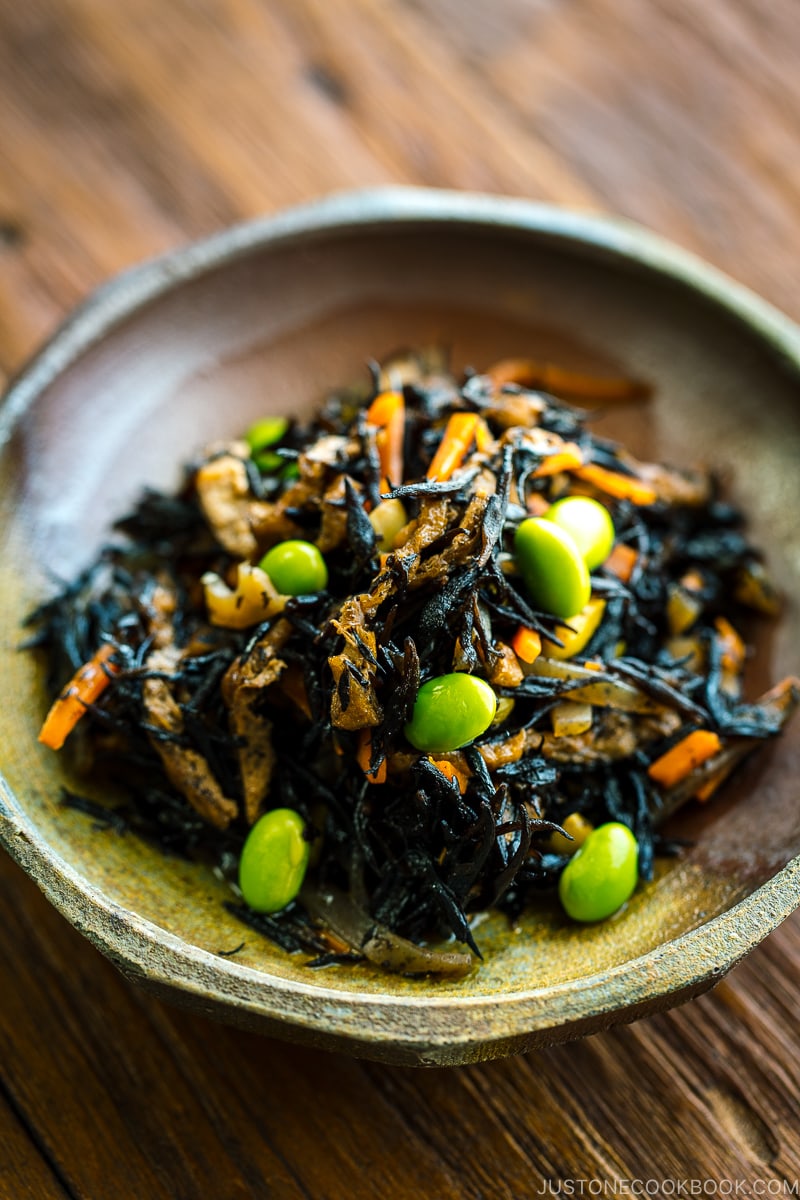
If you’re looking to include more sea vegetables into your diet, you’ll want to give hijiki a try. Resembling dried tea leaves but longer, hijiki is a type of wild sea vegetable that grows on rocky coastlines around Japan, Korea, and China. It has a sweet, clean taste and mushroom-like quality.
In Japan, we often enjoy it as hijiki no nimono (ひじきの煮物), which translates to “simmered hijiki.” It is technically a cooked dish, but you’ll find it called Hijiki Seaweed Salad at Japanese restaurants in the US.
Table of Contents
What is Hijiki Seaweed?
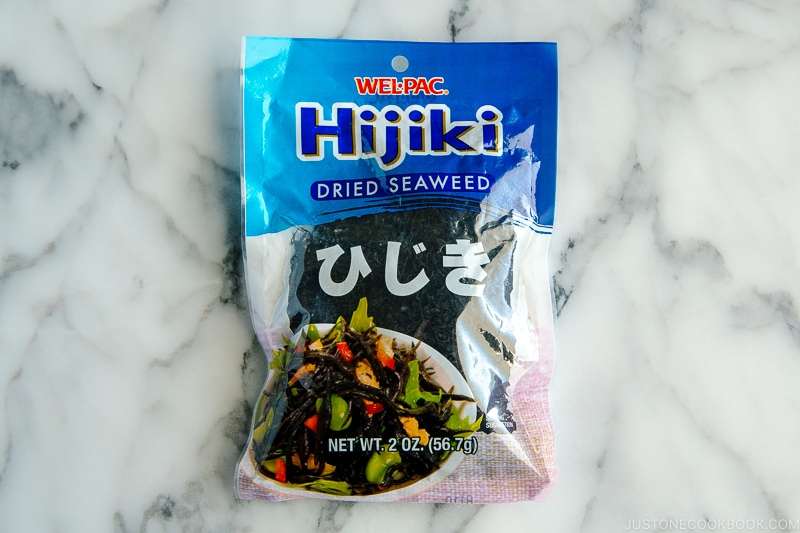
Hijiki seaweed is naturally green or brown in color when it’s hand-harvested by fishermen and divers in the wild. Before it’s packaged, hijiki is boiled and then dried, and this process turns hijiki black. You will need to rehydrate it by soaking it in the water prior to cooking.
Like other edible sea vegetables, hijiki is known for its dietary fiber and essential minerals like iron, calcium, and magnesium. After it’s cooked, it has a pleasant crunch and chewy bite. The taste is more earthy rather than oceany. The Japanese have been enjoying this traditional food as a part of a balanced diet for centuries.
Why You’ll Love This Recipe
- Great textures and flavors: It’s savory, sweet, and pleasantly crunchy
- Versatile: Serve this side dish in a Japanese dinner, lunch menu set, or bento box
- Meal-prep and freezer friendly: Make a big batch to enjoy throughout the week! It keeps in the fridge for 3–4 days or in the freezer for up to a month
- Packed with nutrients: Full of dietary fiber and minerals
Ingredients for Hijiki Seaweed Salad
You can leave out the optional ingredients, but hijiki salad always includes aburaage and edamame.
- dried hijiki seaweed – find it at Japanese supermarkets, Asian grocery stores, natural food stores, or online
- aburaage (fried tofu pouch) – adds protein and a lot of flavor
- carrot – adds color and nutrition
- edamame (young soybeans) – provides plant-based protein and a satisfying bite
- lotus root (renkon) – optional, but it adds a nice crunchy texture
- konnyaku (konjac) – optional; a jelly-like plant food unique to Japanese cuisine that’s very low in calories and high in fiber
- dashi – use homemade dashi, a dashi packet, or Vegan Dashi for vegan/vegetarian
- seasonings – soy sauce, mirin, and sugar
How to Make the Best Hijiki Seaweed Salad
There are various ways to prepare hijiki no nimono, but I really love my mom’s version. This is very close to how she cooks the dish.
- Soak the hijiki seaweed in plenty of water for 30 minutes. In the meantime, prep the other ingredients.
- Sauté the julienned carrots and sliced lotus root. Then, add the rehydrated hijiki, aburaage strips, and konnyaku strips.
- Add the broth and seasonings and simmer for about 30 minutes.
- Add the edamame and continue to simmer until the sauce cooks down and the ingredients soak up the simmering liquid.
- Cool to room temperature so the flavors mingle and settle in. Serve at room temperature.
Cooking Tips
- Season generously – When a dish is eaten at room temperature, you want to be generous with the seasonings so the flavors come through. Do not cut down on the sugar as we use it to balance the salt and enhance the overall taste.
- Don’t skip the fried tofu pouch – The sponge-like texture of the aburaage gives great depth, mouthfeel, and flavor to the dish, so don’t skip it.
- Make a big batch – Simmered hijiki is exactly the kind of dish that Japanese home cooks include in their meal prep. It keeps well and can easily enjoy throughout the week. You can mix it with white steamed rice to make Maze Gohan (Mixed Rice), add on top of soba noodles, or use it to make rice balls.
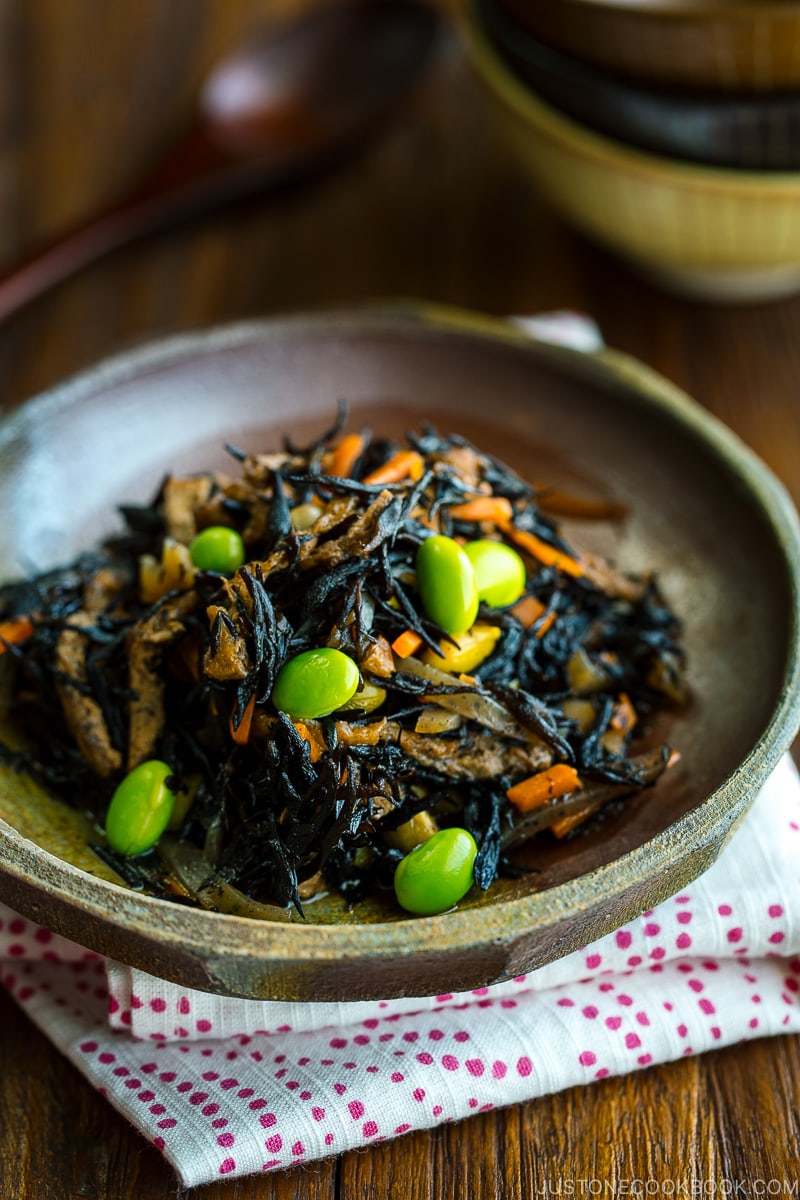
What to Serve with Hijiki Seaweed Salad
With contrasting textures and a concentrated sweet-savory flavor, Hijiki Seaweed Salad makes a truly unique Japanese dish that highlights the beauty of sea vegetables. I hope you enjoy it.
Try serving Hijiki Seaweed Salad with Grilled Mackerel, Japanese Spinach Salad with Sesame Dressing, White Steamed Rice, (Takikomi Gohan), and Miso Soup for a Japanese-style ichiju sansai meal.
Popular Similar Dishes
- Simmered Kabocha Squash
- Simmered Taro
- Simmered Koyadofu
- Simmered Bamboo Shoots
- Simmered Kiriboshi Daikon
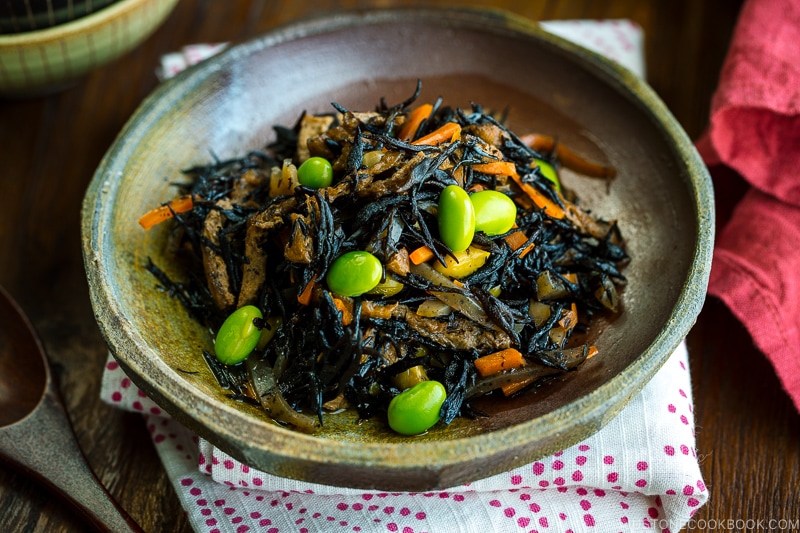
Wish to learn more about Japanese cooking? Sign up for our free newsletter to receive cooking tips & recipe updates! And stay in touch with me on Facebook, Pinterest, YouTube, and Instagram.
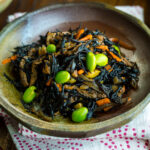
Hijiki Seaweed Salad
Video
Ingredients
- ½ cup dried hijiki seaweed (1 oz; increases tenfold after rehydration; I used mehijiki (芽ひじき), the small, soft “buds“ of the hijiki plant; you can also use the long and chewy “stems” called nagahijiki (長ひじき), which are less commonly found in the US)
- 4 cups water (for soaking)
- 2 aburaage (deep-fried tofu pouch) (1.4 oz, 40 g; you can substitute crispy fried tofu cubes from an Asian grocery store, but blanch them first to remove the excess oil)
- 3 oz konnyaku (konjac) (⅓ konnyaku block; optional)
- 3 oz carrot (½–1 carrot)
- ¼ lotus root (renkon) (1.3 oz, 37 g; pre-boiled; optional)
- 1 Tbsp neutral oil
- 2 cups dashi (Japanese soup stock) (use standard Awase Dashi, dashi packet or powder, or Vegan Dashi)
- ⅓ cup shelled edamame (2 oz, 60 g; cooked; optional)
Instructions
- Gather all the ingredients.
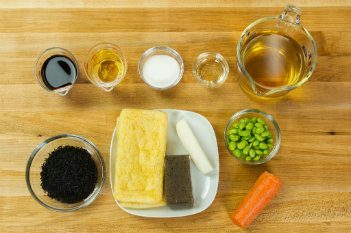
- Soak ½ cup dried hijiki seaweed in 4 cups water—10 minutes for mehijiki (bud hijiki) or 30 minutes for nagahijiki (stem hijiki). Meanwhile, prepare the other ingredients.
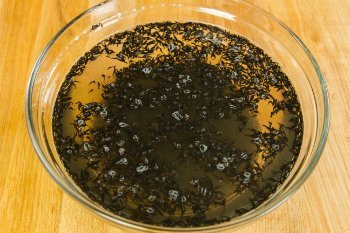
- Drain to a large fine-mesh sieve and rinse under running water.
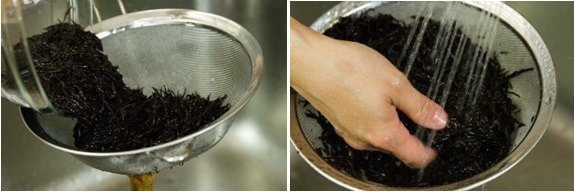
To Prepare the Other Ingredients
- Boil water in a small saucepan and pour it over 2 aburaage (deep-fried tofu pouch). This will remove the excess oil on the aburaage. Squeeze out the liquid. Then, cut in half lengthwise and thinly slice crosswise.

- Add some water and 3 oz konnyaku (konjac) to a small pot and boil for 3 minutes to remove the odor. This also helps the konnyaku absorb flavors and improves the texture. Then, slice it into small strips (about the same size as the aburaage slices).

- Cut 3 oz carrot into julienne pieces.

- Cut ¼ lotus root (renkon) into thin quarter pieces.
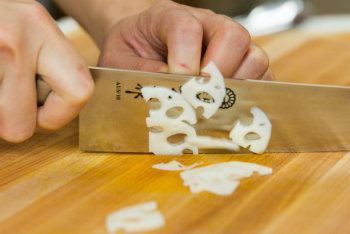
To Cook the Hijiki Salad
- Heat 1 Tbsp neutral oil in a medium pot over medium heat. Add the carrot and lotus root and cook until they are coated with oil.

- Add the hijiki, then the konnyaku and aburaage. Mix it all together.

- Add 2 cups dashi (Japanese soup stock) and let it boil.
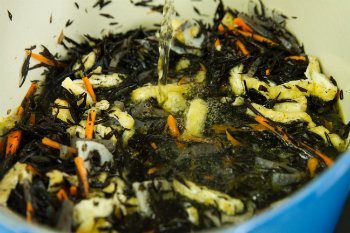
- Add all the seasonings: ¼ cup mirin, 2 Tbsp sugar, and ¼ cup soy sauce. Mix well. Cook covered on medium-low heat for 20–30 minutes.

- Add ⅓ cup shelled edamame.
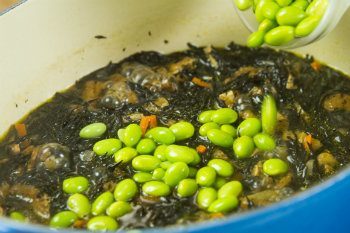
- Continue to cook, uncovered, to reduce the sauce until you see the bottom of the pan.
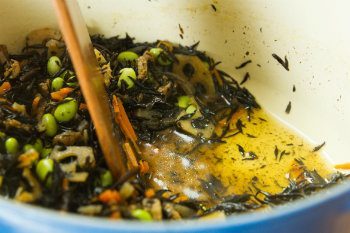
To Serve
- Serve as a side to a Japanese meal or pack in a bento lunch box. For convenient meal prep, you can divide the Hijiki Salad into a bento portion in silicone cups for freezing.
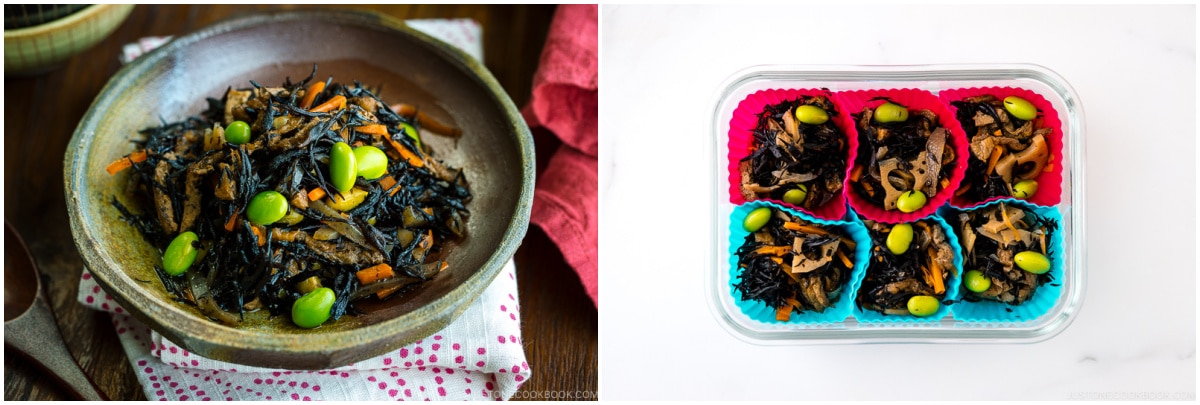
To Store
- Store in an airtight container and keep in the refrigerator for up to 3–4 days. You can also freeze it for up to a month.
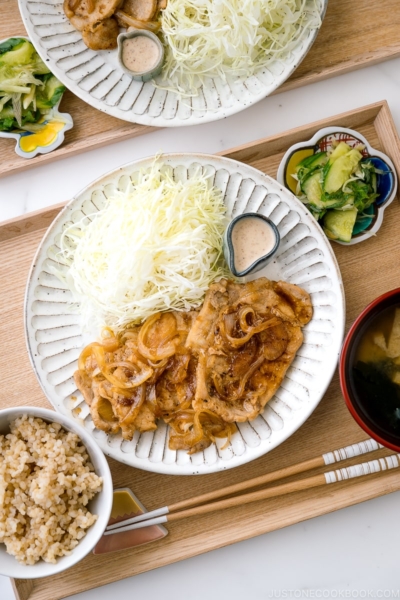
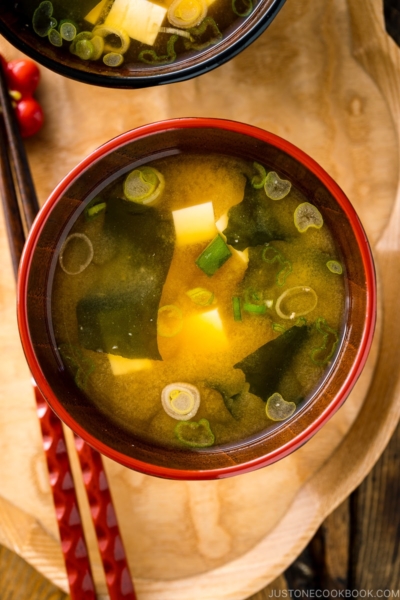

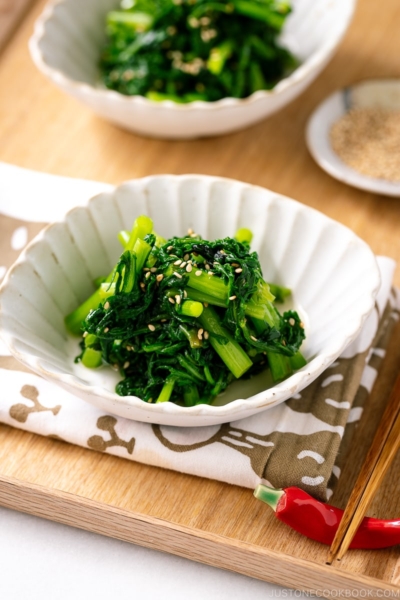




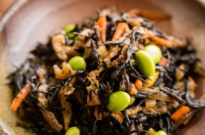
Thank you Nami! I brought this to the Japanese community in my area, and folks love it!
Hello TRL! That’s wonderful! 🥰
Thank you so much for trying Nami’s recipe and for your feedback!
This is delicious. I used to love hijikidon at a restaurant in the East Village (NYC) called Dojo, where a lot of students and folks in the arts would eat for a bargain – it’s long gone now. Your recipe turned out great for me.
It did take a long while to simmer down to “seeing the bottom of the pan” but it was worth the wait. I ultimately don’t regret adding 2 cups of dashi (based on another commenter below) but the long-ish simmer time was a bit of a surprise. Extra patience was required.
My only note would be to add the edamame later, when it’s getting closer to simmered down, not at the beginning when you add the seasonings. That gives it long enough for the edamame to be heated/cooked into the dish, but not so long that they lose their color.
Hi Marlene, Thank you so much for trying Nami’s recipe and for your feedback!
Regarding 2 cups of dashi, You can reduce it to 1 cup as long as the ingredients are well submerged to simmer. 🙂
We hope this helps on your next try.
If people are planning on storing it in the freezer, I assume the best way to serve is to thaw it in the fridge and serve as is?
Hi スティブン, Thank you for trying Nami’s recipe!
Yes, you can defrost it in the fridge or microwave it.
We hope this helps!
なおみさん、ありがとう!
Do you or Nami have a suggested freezer life for the Hijiki Seaweed Salad? I would imagine a minimum of a month. What have been your guys’ experiences with freezing?
スティブン、どういたしまして!
They can be frozen for up to one month, but for the best flavor, we recommend enjoying them as soon as possible.
We hope this was helpful!
Can we use Arame seaweed instead of Hijiki? I could not find hijiki in my local Japanese store
Hi Amelia, Thank you for trying Nami’s recipe!
Sure, you can use Arame instead. However, the soaking time in the water will be much shorter (about 10 minutes) and the texture will be harder than Hijiki.
We hope you like it.
My mom used to make hijiki gohan and as a kid I thought it was weird. Why was it that color? We kids didn’t know. She also made gohan with adzuki, also weird to me as a kid. At Tokyo Fish Market in Berkeley, California they make a version of hijiki salad that includes quinoa. The quinoa adds to the texture of the salad and soaks up the sauce. I added quinoa to your recipe and omitted the konnyaku when I prepared the salad today. I was lazy and bought a bag of matchstick carrots. Aburaage in the can sometimes has a metallic flavor but I found the frozen ones at Yaoya-San, my local Japanese market in El Cerrito, California. Delicious salad!
Thank you for all of your wonderful recipes and for the Japanese food ingredients and cooking tools education. Domo arigato gozaimasu.
Hi Elizabeth! Thank you very much for sharing your cooking experience with us and mentioned about quinoa!
This recipe is a traditional way to make Hijiki Salad but adding quinoa to it is a great addition and nutritious to the dish. Wonderful!🙂
Thanks for this inspiration! I used the seasoning (replaced sugar with maple syrup as it blends easily) on wakame, goji and carrots as a side salad and it’s yummy!
Will try your original recipe too! =^.^=
Hi Angelina! We are glad to hear you enjoyed this dish!
Thank you very much for sharing your experience and for your kind feedback!
Ah hah!! I had this as a side dish in a bento one time and I’ve loved it. Can’t wait to try making this
Hi Annie! We are glad to hear you found this recipe!
We hope you enjoy the homemade Hijiki Salad!
Can I live with you 😂😂😂 I love Japanese food. Just made some hand roll for tonight dinner. Glad I found your page.
Hi Kat!😁 We are glad to hear you found our site! Nami will continue to share many recipes with you! We hope you enjoy them.
Thank you for trying Nami’s recipes and for your sweet feedback.😊
I made this today and also added some shiitake mushrooms – oishi! Such a little amount of hijiki expands so much, amazing! Thank you for sharing your recipe!
Hi FT, Yes! Hijiki expands so much!😁 We glad to hear you enjoyed this recipe with extra shiitake mushrooms. Thank you for trying this recipe and for your kind feedback!
I love this salad and whenever I am in Japan, I would always look for this! I live in the Philippines and it’s quite difficult to find Japanese ingredients. So happy I found ingredients for this in a small Japanese store and cooked this as soon as I got home. It was perfect! Tastes just the way I remember it! Thank you so much for this recipe!
Hi Khonie!
We are so happy to hear you were able to find the ingredients in the Japanese store too!
We know it’s hard to get the Japanese ingredients in the other country sometimes. Thank you very much for trying this recipe and for your kind feedback!
Love your plating and beautiful ceramic dinnerware. I recently bought some from a local market. I noticed on the back label that it said “this product may cause cancer.” I went back to the store and looked at other ceramic dishes and most had same label. Have you encountered this? Any recommendations on where to purchase? Please advise. Thank you.
Hi Priscilla! No, I don’t remember having the labels before. Maybe if there is a small trace of it they have to label it… just like the seaweed products in California. They have to label it even though you have to eat impossible amount of seaweed to eat to be affected. I’m not too sure. Sorry, I wish I know the answer.
Question: can you freeze this? My husband soaked an entire bag of it (he did not know what we had doing!) and so I made a LOT of this salad (with modifications as we don’t have access to lotus root here or Japanese stores). I would hate to see it go to waste but the bag made about 5 cups of salad!
Hi JC! I apologize for my late response. Thank you for trying this recipe! Yes, you can definitely freeze this salad and it’s a great meal prep dish. 🙂
Hi Nami,
Konnichiwa.
I try my best to make a majority of your recipes….I love them!!
I have made the Hijiki Salad twice now, following your recipe exactly, but adding “2 cups” of dashi makes for a very liquidy mixture that takes forever to boil off (note than an hour and there is still liquid). The taste overall is excellent, but I have made a note to my printed recipe to use only 1 cup of dashi the next time.
Hiroyuki
Konnichiwa Hiroyuki! I’m happy to hear you enjoy my recipes. Thank you for your kind feedback. Regarding 2 cups dashi, yes 1 cup works fine too as long as ingredients are well submerged to simmer. 🙂
I have enjoyed hijiki salad in Bento boxes at several of my favorite Japanese restaurants in towns I used to live in – but now I live in Tucson where nobody seems to serve it so I would like to make my own. Hijiki was easy to buy at our local Asian market, but Abura age and honnyaku are not available. There seem to be quite a few different choices fried tofu products that are Korean or Vietnamese (?), however. Would you have any insight into what to choose as a substitute?
Hi Jeanette! So I think you can do one of the following ways:
1) the Korean grocery store should carry “Inari Age” (in Japanese) or “yubu” (in Korean) as we have a similar dish. But those are already seasoned (sweet!), so you have to reduce the overall sweetness in Hijiki Salad.
2) buy deep-fried tofu (Vietnamese or Thai or Chinese) that are smaller cubes and you cut into julienned pieces similar to hijiki.
Hope this helps! So sorry for my late response.
I LOVE hijiki and this is such a lovely salad recipe. I.cannot wait to try this. Love the mic of ingredients in this . It looks SO good, and light but filling. Thank you Nami.
Hi Lynn! Hope you enjoy this dish. Adjust the amount of sugar – typically this dish is on the sweeter side, but it’s up to you to cut down. 🙂